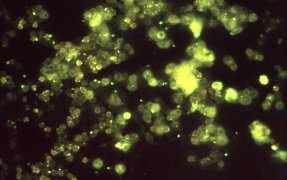Representative figure legend
Immunocytochemistry/Immunofluorescence analysis using Mouse Anti-PINK1 Monoclonal Antibody, Clone S4-15 (SMC-450). Tissue: Neuroblastoma cell line SK-N-BE. Species: Human. Fixation: 4% Formaldehyde for 15 min at RT. Primary Antibody: Mouse Anti-PINK1 Monoclonal Antibody (SMC-450) at 1:100 for 60 min at RT. Secondary Antibody: Goat Anti-Mouse ATTO 488 at 1:100 for 60 min at RT. Counterstain: Phalloidin Texas Red F-Actin stain; DAPI (blue) nuclear stain at 1:1000; 1:5000 for 60 min RT, 5 min RT. Localization: Cytoplasm. Magnification: 60X. (A) DAPI (blue) nuclear stain (B) Phalloidin Texas Red F-Actin stain (C) PINK1 Antibody (D) Composite. Western Blot analysis of Rat Brain showing detection of ~50 kDa PINK1 protein using Mouse Anti-PINK1 Monoclonal Antibody, Clone S4-15 (SMC-450). Lane 1: Molecular Weight Ladder. Lane 2: Rat Brain. Load: 15 µg. Block: 2% BSA and 2% Skim Milk in 1X TBST. Primary Antibody: Mouse Anti-PINK1 Monoclonal Antibody (SMC-450) at 1:200 for 16 hours at 4°C. Secondary Antibody: Goat Anti-Mouse IgG: HRP at 1:1000 for 1 hour RT. Color Development: ECL solution for 6 min in RT. Predicted/Observed Size: ~50 kDa. Mouse Anti-PINK1 Antibody [S4-15] used in Immunocytochemistry/Immunofluorescence (ICC/IF) on Human Neuroblastoma cell line SK-N-BE (SMC-450) Mouse Anti-PINK1 Antibody [S4-15] used in Western Blot (WB) on Rat Brain (SMC-450)
